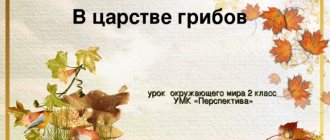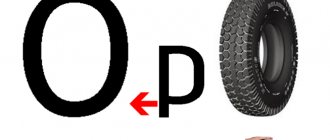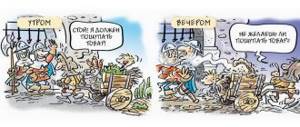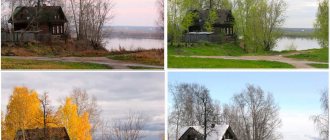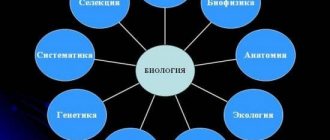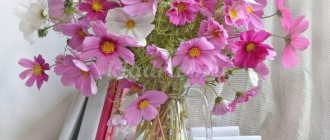Lesson 42. CONSERVATION OF NATURE IN WINTER
Objectives of the lesson: to develop in children an aesthetic sense when perceiving the beauty of winter nature; strengthen a caring attitude towards nature by introducing children to the rules for keeping parks, squares, forests clean in winter, and ways to feed animals and birds; continue studying the pages of the Red Book.
Planned results: follow the rules of cleanliness while walking in a winter park, square, forest - do not leave garbage behind; make simple bird feeders; know the characteristics of the winter life of 2-3 wild animals.
During the classes
1. Org. class
2. Introductory conversation.
The teacher begins the lesson by examining the children's work on the stand and says:
– Guys, this extraordinary winter forest has been “planted”, created by our hands, imagination, and creativity. What word do you think the word “creativity” comes from? What words is the word “create” similar to? (Do, create.) This means to create - to do, to create something beautiful, wonderful. Do you think it is possible to create and not take care, not protect, not love your creation? Don't protect him from harm? So let's imagine that we are forest rangers in this marvelous forest. Who knows what a forester does? (Protects the forest, nature.) Now let’s think about it. This painted forest is only a few days old. And in our game it could be a centuries-old forest. He has already survived many springs and winters. And you, as foresters, must take care of it at all times of the year. And so the children came to you on an excursion (the teacher takes out assistant dolls) and wanted to learn how to protect nature in the fall. What could you tell them, explain? (Children’s answers.) And here are the following questions from our excursionists: “Who is the spruce tree “friends” with? Which Red Book representatives can you tell us about?
(Teacher: “I’ll give you a hint: who did you learn about in the fall?”)
– And now you can go on a journey through the winter forest!
3. Work on the topic
– Guys, if you’ve been paying attention, then in every forest there are warning signs about correct behavior in the forest. Our forest is no exception. It is necessary to explain to guests the encrypted rules of nature conservation in winter.
Children give their explanations.
The teacher supplements the children's description of each sign by reading the text on p. 52-53 of the textbook and asks what other rules for protecting nature in winter can be proposed.
– Now let’s check what our excursionists understood and remembered, and ask them how they can participate in nature conservation in winter.
“It’s time to take a short break and listen to the “story of the forest.”
He reads the story “The White Fairytale Palace” from the book “The Giant in the Clearing” (pp. 91-92).
After reading, he asks you to think about how best to organize the competitions mentioned in the story.
4. Physical exercise
5. Working on the topic (Continued)
– And now we will move to the most protected part of our forest. Animals that are becoming increasingly rare in the wild live here. And in real life they live in different parts of the Earth. And a meeting, for example, between a polar bear and a tiger in the wild is impossible. What unites them, unfortunately, is the Red Book, under the cover of which they found protection. But in a fairytale forest, everything is possible, and we can introduce our guests to the amazing inhabitants of the forest zoo.
The teacher asks what the children know about each of these animals, then reads the explanations on p. 54-55 of the textbook.
– Which representatives of the Red Book of Russia did we learn about in class? What animal protection measures can be proposed for them? - and suggests completing task No. 4 on p. 29 of the workbook, and after the teacher presents additional regional material - task No. 5 on p. 29 workbook.
- It's time to return home from the winter forest.
6. Reflection
- Guys, of course, we understand that it was a game. But the rules we have named are very important in real life. They need to be followed for a walk in the yard, in a park, square, or a real forest. Then we will remain creators of beauty not only on paper, in our drawings, but also in real life. Being beauty creators is not difficult. The main thing is to maintain a caring attitude towards the world around you, a love for your native nature.
After this, the teacher asks a student who reads well to read the conclusion of the lesson on p. 55 textbook.
7. Homework : theoretical material on p. 52-55 of the textbook, tasks No. 1, No. 2 and No. 3 on p. 28-29 workbook.
The world
Lesson 1. SPRING MONTHS
Objectives of the lesson: to teach children to correlate the signs of the coming spring in living and inanimate nature, as well as events in the lives of people in the spring with the meaning of the ancient names of the spring months in the language of the peoples of their region; show the social and moral meaning and beauty of folk signs and customs of the day of Evdokia-Vesnovka as an ancient spring new year; develop children’s emotional and value-based attitude towards nature and works of verbal and visual creativity; expand the vocabulary of younger schoolchildren, teach them to use the expressive means of their native language to describe the beauty of spring nature and works of art dedicated to this topic; continue to introduce children to the artists A.K. Savrasov and B.M. Kustodiev and the main themes of their artistic creativity.
Planned results : learn to find signs of spring natural phenomena and indications of the peculiarities of people's lives in spring in the ancient names of the spring months; describe the beauty of spring nature and works of art dedicated to this topic, using the expressive means of their native language; conduct weather observations on March 14 to compare their results with the results of upcoming observations on May 6; name those features in the fate and works of artists that caused an emotional experience in each of the students.
During the classes
1. Org. class
2. Introductory conversation.
– Guys, please look at the reproductions of paintings and drawings on p. 58-59 of the textbook. Guess what time of year we will be talking about today. What helped you understand this? What signs of spring did you see in drawings and paintings? Who remembers when the first meeting of spring is celebrated according to the folk calendar? Who can name the spring months in order? Now look again at the artists’ paintings and try to determine in which of the spring months nature could have looked like this? Which of the paintings best suits the poem by A. A. Korinfsky? (The teacher reads the poem on page 58 of the textbook.)
3. Work on the topic
– Spring has always inspired poets to create poems. Let's try to find rhymes for the names of the spring months. And first, I will tell you what spring rhymes the writer, author of stories about a hedgehog and a bear cub, Sergei Kozlov found in the wonderful cycle of poems “The Golden Carousel”1: March - glad, April - drops, May - get up. And now guys, it's your turn. So: March - ..., April - ..., May - ....”
– Remember, we told you that the popular names of the months are also similar to works of art. They accurately note and summarize in one or two words the features of changes in nature that occur in a given month. Now we will once again be convinced of this by the example of the names of the spring months.
– The names of the spring months are all joyful: one can hear in them the cheerful chatter of spring streams, the chirping of birds, the gentle rustling of young leaves. Try to explain what the ancient names of the spring months mean. What natural phenomena are they talking about?
– Look at the paintings again and tell me which of the ancient names are suitable for these landscapes.
Then children complete tasks No. 1 and No. 2 on p. 32 workbooks.
4. Physical exercise
5. Working on the topic (Continued)
- Guys, tell me, who noticed which spring month has the most names? (March.) This is the first month of spring, and, probably, having waited for spring, people greeted it with such joy, which resulted in a large number of names. But the month of March had one more feature in the old days. Listen, please.
The teacher reads the text “Spring New Year” on p. 60 of the textbook with students counts how many days are left until this date or how many have already passed. Draws children's attention to the image of Saint Eudoxia, to the subtlety in the depiction of the face and clothing, to the tenderness of the surrounding landscape. He explains that the name Evdokia means “favor” in Greek.
- Now look at p. 58 of the textbook and find an image of Spring, made according to the folk artist’s ideas about beauty.” After the children find a photograph of the toy, the teacher discusses its features with the children: what colors the toy is painted in; what signs help determine that this figurine depicts Red Spring.
– Why does the toy Spring-Red have a bird in her hands?
Children give their explanations.
Next, one of the students reads the last paragraph on p. 60 and the text of the spring call on p. 61 textbooks.
Students look at the artist's drawing on p. 60 and a photograph of the doll on p. 61 textbooks and then answer the teacher's questions.
- Let's discuss with you what gifts of spring are mentioned in the call. What is “a box of life, two - wheat”? Why is wheat so affectionately named? Why, in connection with what holiday, are “eggs” considered gifts of spring? What will “rings” please girls with? What joy does spring have in store for young women, the “youngsters”? What kind of joy will the “old men and old women” have? Which gift do you find most joyful? Now we will try to play this call in our own way:
Nature conservation in winter
There are several ways you and I can preserve nature and help it, see for yourself.Look at the screen, in front of you are pictures that encode the rules for protecting nature in winter.
Let's try to formulate them.
What is shown in the first picture? Is the winter forest beautiful? What exactly makes him so attractive?
Imagine that you are scientists and researchers. Your object of research is snow. Is snow useful or harmful?
Guys, do you think it’s easy for trees in severe frosts?
But, do not be afraid, the trees have adapted to this; their branches are covered with a special protective layer that protects them from drying out in frosts.
But what’s surprising is that winter cold is simply necessary for forest plants. It turns out that the buds of trees and shrubs can bloom normally only after winter cold.
Yes, it’s true that snow is a helper for plants, but in large quantities it can harm trees.
Twigs are shaken off snow to help the trees. Also, many trees are covered to save them from wind and snow.
We learned how snow affects plants, and how does it help animals, what do you think?
And when crust forms on the snow, do you know what crust is? Does he help animals?
How does it affect birds that spend the night under the snow? (grouse, black grouse)
You see that the beauty of a snow cover can be deceptive, and snow both helps and harms many plants and animals.
When we come to the park, what do we usually do? What could this mean? How should we behave?
So what will be our first conservation rule?
In winter, everyone tries to hide from the frost, from the cold, icy wind, and everyone has adapted to winter in their own way, so you need to help and not disturb their peace.
Look at picture 2. What could it mean? How should we behave in nature?
Why can't you leave trash?
Can you imagine?
-The paper does not rot for 2 years.
-Cellophane does not rot for 200 years.
-A tin can can hurt your leg even after 30 years.
In winter, the garbage may not be noticeable, since it is under the snow, but in the spring everything secret will become clear.
Look at the picture, what will our second rule be?
Pay attention to figure 3. What does it show? What could this mean? Why can’t we cut down spruce trees, because everyone does it anyway? Remember who the spruce is “friends” with.
How can you do without spruce on New Year's Eve?
Who is shown in picture 4? What do birds suffer from in winter, and why? How can we help them?
Let's look at figure 5. What's in front of us? What is this hay for, do you think? For which animals? Who feeds them?
Who is shown in the last picture? How can we help squirrels?
Tell me, can you feed it with anything?
Well done, we have formulated all the rules for protecting nature in winter.
Let's repeat what each of us can do to preserve nature in winter. Is this difficult for us to do?
Let's follow these simple rules and then nature will delight us with its wealth and beauty.

